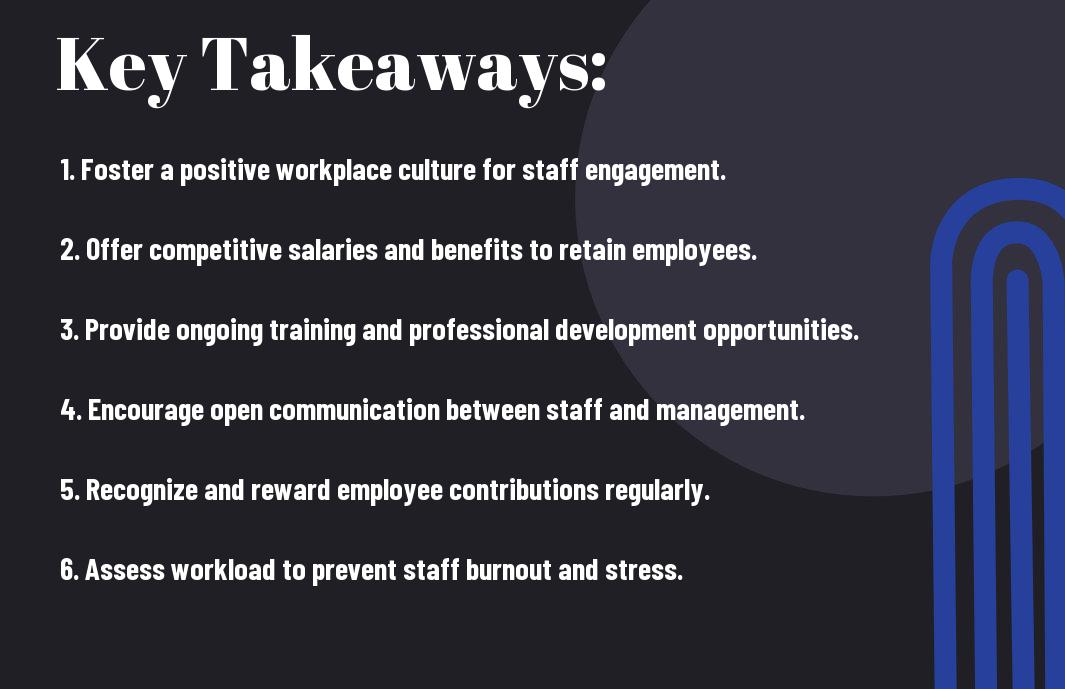Best practices for retaining staff in Residential Care Facilities for the Elderly (RCFEs) can significantly enhance your organization’s stability and success. By implementing effective recruitment strategies, fostering a positive workplace culture, and prioritizing professional development, you can create an environment that encourages employee loyalty and engagement. Understanding the factors that contribute to turnover will not only help you keep your staff happy but also improve the quality of care your residents receive. Let’s explore these best practices to ensure your facility thrives.
Key Takeaways:
- Employee Engagement: Foster a culture that encourages open communication and feedback. Actively involving staff in decision-making can enhance their commitment to the organization.
- Professional Development: Invest in training and career advancement opportunities. Providing staff with paths for growth can increase job satisfaction and retention rates.
- Work-Life Balance: Promote a healthy work-life balance by offering flexible scheduling and support for personal commitments. This approach can lead to higher morale and reduced turnover.

Understanding Turnover in RCFEs
Before exploring retention strategies, it’s important to understand what turnover looks like in Residential Care Facilities for the Elderly (RCFEs). High turnover rates not only disrupt the quality of care delivered but also impact the overall environment of your facility. To effectively implement retention practices, recognizes the underlying causes and the effects on both staff and residents.
Key Factors Contributing to Turnover
To tackle turnover, it is imperative to identify the key factors that contribute to it in RCFEs. Common reasons include:
- Low compensation
- Overwhelming workloads
- Poor management
- Limited career advancement
Any of these influences can impact employee satisfaction and their decision to leave.
Impacts of High Turnover Rates
By experiencing high turnover rates, you face numerous challenges that affect your RCFE’s operations. This can lead to diminished morale among remaining staff, increased recruitment costs, and inconsistency in resident care. The lack of stability could further generate feelings of uncertainty, affecting both your teams and the residents’ well-being.
Indeed, high turnover can result in significant financial strain due to the costs associated with hiring and training new employees. Furthermore, it disrupts team cohesion, leading to a work environment that can feel unsafe for both staff and residents. The fluctuation in care providers means relationships with residents may suffer, ultimately affecting their overall satisfaction and quality of life at your facility. Mitigating these issues demands a focused approach to retaining talent while fostering a supportive workplace culture.
Best Practices for Staff Retention
Some of the best practices for retaining staff in Residential Care Facilities for the Elderly (RCFEs) revolve around creating a supportive workplace culture that prioritizes employee satisfaction and engagement. By fostering open communication, recognizing achievements, and providing opportunities for growth, you can significantly reduce staff turnover and enhance the overall stability of your team.
Competitive Compensation and Benefits
By offering competitive salaries and a comprehensive benefits package, you can attract and retain the best talent in the industry. Benefits such as health insurance, retirement plans, and paid time off not only boost your employees’ morale but also demonstrate your commitment to their well-being.
Comprehensive Training and Development Programs
Around 75% of employees agree that training opportunities greatly influence their job satisfaction. By providing robust training programs, you empower your staff with the skills necessary to excel in their roles and adapt to changing demands. This encourages career development and fosters a culture of continuous learning, making your employees feel valued and motivated.
Benefits of implementing comprehensive training and development programs are significant. You can enhance your staff’s confidence and competence, leading to improved performance and resident satisfaction. Furthermore, as your employees grow in their roles, they build a sense of loyalty to your organization, reducing turnover rates. Investing in your staff’s professional growth not only creates a high-performing team but also promotes a positive workplace culture where employees feel supported and valued.
Creating a Positive Work Environment
Unlike traditional workplaces, a positive work environment in RCFEs thrives on mutual respect and support among team members. This atmosphere fosters employee satisfaction and encourages engagement, which can significantly enhance staff retention. By prioritizing a culture of open communication and inclusivity, you can empower your staff, making them feel valued and appreciated. Investing in a positive work environment not only uplifts morale but also contributes to optimal resident care.
Fostering Team Collaboration
Positive team collaboration is vital in RCFEs, as it encourages staff to work together seamlessly. By organizing regular team-building activities and promoting open lines of communication, you create a culture of unity that drives collective success. Engaging staff members in group discussions and decision-making processes fosters a sense of belonging and enhances the overall work experience.
Recognizing and Rewarding Achievements
Positive recognition and rewarding achievements can significantly impact employee morale in your RCFE. When you acknowledge the hard work and dedication of your staff, they feel valued and motivated to excel in their roles. Implementing a reward system or celebrating accomplishments can go a long way in promoting job satisfaction and retention.
In fact, consistent recognition and support for your staff can lead to a more productive and committed workforce. Developing a structured program for acknowledging individual contributions fosters a competitive yet supportive atmosphere. Consider implementing a monthly recognition program, where staff members receive certificates or small rewards for outstanding performance. Such initiatives not only enhance morale but also create a sense of pride in the workplace. Ultimately, when your staff feels appreciated, their commitment to providing exceptional care will flourish, benefitting both them and the residents they serve.
Engaging Staff Through Communication
After fostering open communication within your RCFE, you will likely see increased staff engagement and satisfaction. Regularly interacting with your team creates a supportive environment that encourages collaboration and trust. By prioritizing effective communication, you can address concerns promptly, celebrate successes, and empower your staff, leading to enhanced retention rates.
Regular Feedback and Performance Reviews
Reviews are imperative for guiding your staff’s development and maintaining motivation. Conducting regular feedback sessions allows you to acknowledge achievements while addressing areas for improvement. This two-way dialogue fosters a sense of belonging and encourages employees to take ownership of their roles, ultimately enhancing their commitment to your facility.
Open Door Policies and Staff Input
Around your facility, it’s important to establish a culture where staff feel comfortable voicing their opinions and concerns. An open door policy invites employees to share their thoughts without fear, which can lead to innovative ideas and improvements in care practices. By actively seeking your staff’s input, you show that their contributions are valued, fostering loyalty and reducing turnover.
But implementing an effective open door policy involves more than just leaving your doors physically open. It requires creating a trusting environment where staff feel safe and confident expressing their ideas or concerns. Encourage your team to participate in discussions and implement their suggestions when appropriate. This not only boosts morale but also enhances their satisfaction and commitment to your RCFE, leading to better overall workforce stability.
Implementing Flexible Scheduling
Your ability to implement flexible scheduling can significantly impact staff retention in your RCFE. By allowing employees to choose their shifts or create customized work hours, you empower them to balance their personal commitments and work responsibilities. This flexibility not only increases job satisfaction but also fosters a culture of trust and respect within your team.
Balancing Work-Life Needs
Any organization that values its employees should prioritize work-life balance. By understanding and accommodating your staff’s personal needs, such as childcare, education, or health concerns, you demonstrate your commitment to their well-being. This approach enhances overall job satisfaction, which is fundamental in retaining dedicated employees.
Strategies for Shift Management
Before implementing flexible scheduling, it’s crucial to develop effective strategies for shift management. This includes creating a system that allows staff to easily swap shifts or request time off without disrupting overall operations. Incorporating tools such as mobile apps or shared scheduling software can streamline this process, ensuring that all shifts are covered while accommodating employees’ needs.
Considering the dynamics of your workforce, it’s important to establish protocols for shift swaps and time-off requests. Utilizing a shared platform for scheduling can help you track employee availability and preferences, making it easier for everyone involved. Additionally, promoting an environment where staff can voice their scheduling preferences not only boosts morale but also encourages a team-centric culture. This approach can result in increased productivity, improved job satisfaction, and significantly lower turnover rates.
Building a Strong Organizational Culture
Not only does a strong organizational culture enhance employee satisfaction, but it also significantly lowers turnover rates. Investing time and resources in cultivating a positive environment where values and mission are shared fosters loyalty and engagement among staff members. It promotes open communication, collaborative teamwork, and a sense of belonging, all of which are vital in ensuring that your organization becomes a place where employees thrive and choose to stay.
Values Alignment and Mission Engagement
Strong alignment between your organization’s values and the personal beliefs of your staff can make a significant impact on retention rates. When your employees feel connected to the mission and understand how their roles contribute to the greater good, they are more likely to be motivated and committed to the organization. Creating opportunities for staff to engage with the mission not only boosts morale but also enhances job satisfaction, ultimately fostering a workforce that is dedicated to your community.
Leadership’s Role in Culture Development
On the front lines of culture development, leadership plays a pivotal role in shaping the values and behaviors within your organization. It’s not just about setting the tone; it’s about actively embodying the culture you want to create. Leaders should constantly model the behaviors they wish to see, ensuring they align with your organization’s vision and values. This creates a clear pathway for employees to follow and establishes a sense of trust and stability within your team.
Even small actions by leaders can have a profound effect on shaping the culture of your organization. By communicating openly, providing constructive feedback, and celebrating achievements, you can foster an environment of trust and collaboration. Ensuring that leadership remains engaged and approachable encourages staff to voice their ideas and concerns, which can lead to positive innovations and solutions. Additionally, investing in leadership development can equip your leaders with the tools they need to inspire and motivate your team, ultimately leading to a culture where employees feel valued and eager to contribute.

Summing up
Hence, implementing best practices for staff retention in RCFE settings can significantly reduce turnover rates, enhancing the overall quality of care provided. Focus on fostering a supportive work environment, offering competitive benefits, and investing in employee development. By prioritizing training and skill enhancement, you create a more engaged workforce. For more insights, explore Boosting Senior Living Employee Retention with Training …. Your commitment to staff satisfaction will ultimately lead to improved resident experiences and a stable care team.
FAQ
Q: What are the most effective strategies for reducing staff turnover in RCFEs?
A: Effective strategies for reducing staff turnover in Residential Care Facilities for the Elderly (RCFEs) include fostering a positive work culture, offering competitive compensation and benefits, and providing opportunities for professional development. Encouraging open communication and recognizing staff achievements can enhance employee satisfaction and loyalty. Regularly assessing the work environment and addressing any concerns can also contribute to staff retention.
Q: How important is training and development in retaining staff at RCFEs?
A: Training and development play a significant role in retaining staff in RCFEs. Providing comprehensive onboarding and ongoing training helps employees feel competent and confident in their roles. Additionally, offering continuing education opportunities not only empowers staff but also enhances their career prospects, making them more likely to stay with the organization. Engaging employees in the planning of their professional development can further strengthen their commitment to the facility.
Q: What role does employee feedback play in reducing turnover in RCFEs?
A: Employee feedback is vital in understanding the needs and concerns of staff in RCFEs. Regularly seeking input through surveys, meetings, or one-on-one discussions helps management identify areas for improvement and fosters a culture of inclusivity. When employees feel valued and their opinions are taken into consideration, they are more likely to remain committed to the organization. Implementing changes based on feedback can also enhance overall job satisfaction and retention rates.







